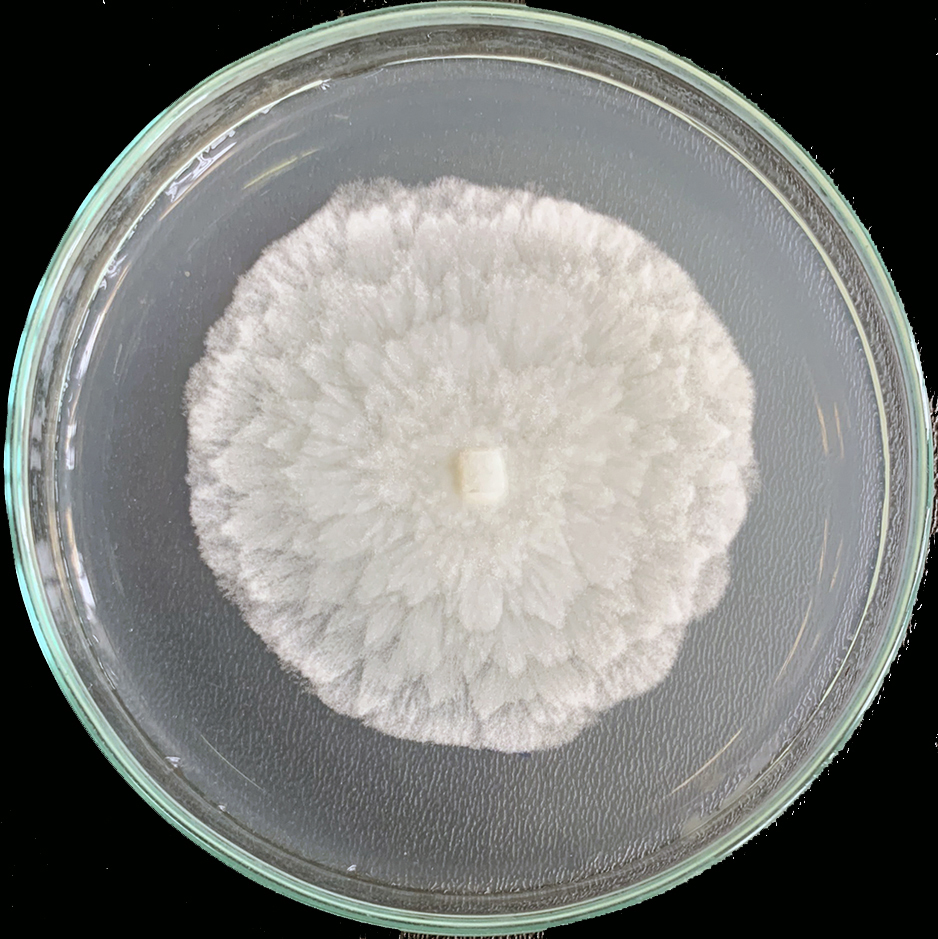Gallery
Image Type
Morphological Structure
Clades
 oogonia with wavy walls containing aplerotic oospores, with large ooplasts which turn golden brown on maturity; antheridia were predominantly paragynous; scale bar = 25micro;m
oogonia with wavy walls containing aplerotic oospores, with large ooplasts which turn golden brown on maturity; antheridia were predominantly paragynous; scale bar = 25micro;m
oogonia with wavy walls containing aplerotic oospores, with large ooplasts which turn golden brown on maturity; antheridia were predominantly paragynous; scale bar = 25µm
Phytophthora spp. in subclade 9d: portion of the seven-loci ML phylogeny featuring the type cultures of 212 described species (by T. Bourret). Notice the position of P. constricta Ex-type CBS 125801 = S&T BL 61. Gloria Abad, USDA S&T.
Phytophthora spp. in subclade 9d: Morphological Tabular key (PDF) and Tabular key legends (PDF) in IDphy2 KEY SECTION. Notice the data of P. constricta Ex-type CBS 125801 = S&T BL 61. Gloria Abad, USDA S&T.
 Phytophthora constricta nbsp;colonies of the ex-type grown for 7 days at 20deg;C on: (a) V8reg; agar, (b) carrot agar, (c) malt extract agar, (d) potato-dextrose agar
Phytophthora constricta nbsp;colonies of the ex-type grown for 7 days at 20deg;C on: (a) V8reg; agar, (b) carrot agar, (c) malt extract agar, (d) potato-dextrose agar
Phytophthora constricta colonies of the ex-type grown for 7 days at 20°C on: (a) V8® agar, (b) carrot agar, (c) malt extract agar, (d) potato-dextrose agar
 ovoid to broadly ovoid sporangia formed on V8 agar flooded with soil extract; (a) evenly wide sporangiophore, (b) extreme constriction of the sporangiophore, (c) detached sporangia which broke off under slight pressure, (d) nested proliferation, (e) nested and extended proliferation, (f) swelling on sporangiophore; scale bar = 25 micro;m
ovoid to broadly ovoid sporangia formed on V8 agar flooded with soil extract; (a) evenly wide sporangiophore, (b) extreme constriction of the sporangiophore, (c) detached sporangia which broke off under slight pressure, (d) nested proliferation, (e) nested and extended proliferation, (f) swelling on sporangiophore; scale bar = 25 micro;m
ovoid to broadly ovoid sporangia formed on V8 agar flooded with soil extract; (a) evenly wide sporangiophore, (b) extreme constriction of the sporangiophore, (c) detached sporangia which broke off under slight pressure, (d) nested proliferation, (e) nested and extended proliferation, (f) swelling on sporangiophore; scale bar = 25 µm
 mature, slightly aplerotic to nearly plerotic bronze-brown oospores each containing a large ooplast and a dark nucleus, with paragynous antheridia (a-c) ; scale bar = 25 micro;m
mature, slightly aplerotic to nearly plerotic bronze-brown oospores each containing a large ooplast and a dark nucleus, with paragynous antheridia (a-c) ; scale bar = 25 micro;m
mature, slightly aplerotic to nearly plerotic bronze-brown oospores each containing a large ooplast and a dark nucleus, with paragynous antheridia (a-c) ; scale bar = 25 µm
Phytophthora spp. in subclade 6a: portion of the seven-loci ML phylogeny featuring the type cultures of 212 described species (by T. Bourret). Notice the position of P. cooljarloo Ex-type CBS 143062 = S&T BL 185. Gloria Abad, USDA S&T.
Phytophthora spp. in subclade 6a: Morphological Tabular key (PDF) and Tabular key legends (PDF) in IDphy2 KEY SECTION. Notice the data of P. cooljarloo Ex-type CBS 143062 = S&T BL 185. Gloria Abad, USDA S&T.
 colony morphology after 5 d growth at 20ordm;C on carrot agar, V8 agar, malt extract agar, and potato-dextrose agar (from left to right)
colony morphology after 5 d growth at 20ordm;C on carrot agar, V8 agar, malt extract agar, and potato-dextrose agar (from left to right)
colony morphology after 5 d growth at 20ºC on carrot agar, V8 agar, malt extract agar, and potato-dextrose agar (from left to right)
 oogonia with wavy walls containing aplerotic oospores, with large ooplasts which turn pale brown on maturity; antheridianbsp;exclusively paragynous, generally situated adjacent to the oogonial stalk; scale bar = 25micro;m
oogonia with wavy walls containing aplerotic oospores, with large ooplasts which turn pale brown on maturity; antheridianbsp;exclusively paragynous, generally situated adjacent to the oogonial stalk; scale bar = 25micro;m
oogonia with wavy walls containing aplerotic oospores, with large ooplasts which turn pale brown on maturity; antheridia exclusively paragynous, generally situated adjacent to the oogonial stalk; scale bar = 25µm
Phytophthora spp. in subclade 6b: portion of the seven-loci ML phylogeny featuring the type cultures of 212 described species (by T. Bourret). Notice the position of P. crassamura Ex-type CBS 140357 = S&T BL 150A. Gloria Abad, USDA S&T.
Phytophthora spp. in subclade 6b: Morphological Tabular key (PDF) and Tabular key legends (PDF) in IDphy2 KEY SECTION. Notice the data of P. crassamura Ex-type CBS 140357 = S&T BL 150A. Gloria Abad, USDA S&T.
 Phytophthora crassamura (CPHST BL 150) colonies of the ex-type grown for 7 days on (a) V8reg; Agar, (b) potato dextrose agar, and (c) malt extract agar; photo by Clinton Greub, Krysta Jennings, and Leandra Knight, USDA-APHIS-PPQ
Phytophthora crassamura (CPHST BL 150) colonies of the ex-type grown for 7 days on (a) V8reg; Agar, (b) potato dextrose agar, and (c) malt extract agar; photo by Clinton Greub, Krysta Jennings, and Leandra Knight, USDA-APHIS-PPQ
Phytophthora crassamura (CPHST BL 150) colonies of the ex-type grown for 7 days on (a) V8® Agar, (b) potato dextrose agar, and (c) malt extract agar; photo by Clinton Greub, Krysta Jennings, and Leandra Knight, USDA-APHIS-PPQ
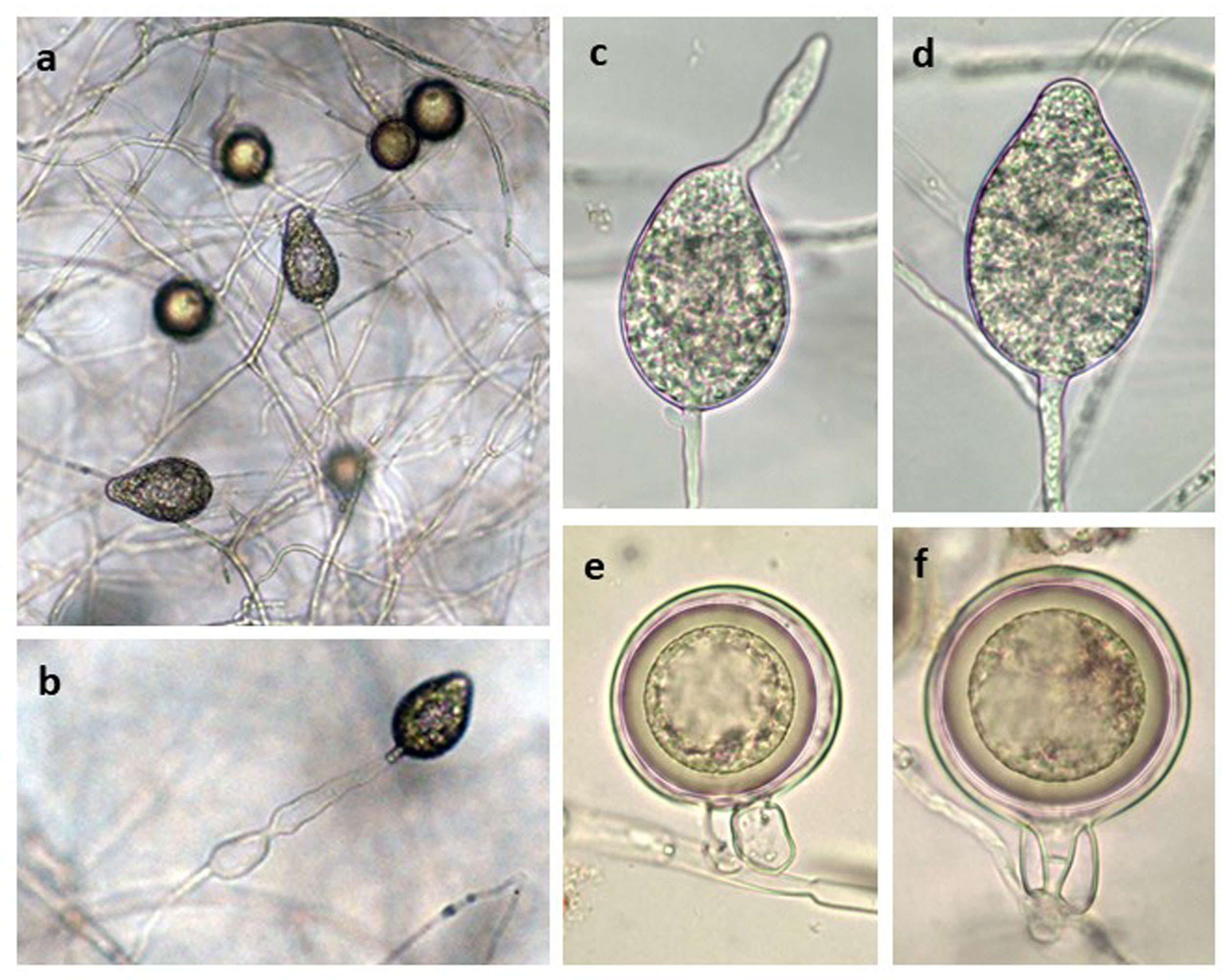 Phytophthora crassamura (CPHST BL 150a) ex-type: asexual phase (a-d) with non-papillate persistent sporangia, (a, b) sporangia borne in unbranched sporangiophores, (c) direct germination, (d) external proliferation, (e) oogonium with aplerotic and thick-walled oospore, and paragynous antheridium, (f) oogonium with aplerotic oospore and amphigynous antheridium; photos (a, b) by Gloria Abad, USDA-APHIS-PPQ, (c-f) by Bruno Scanu, Universitagrave; degli Studi di Sassari, Italy
Phytophthora crassamura (CPHST BL 150a) ex-type: asexual phase (a-d) with non-papillate persistent sporangia, (a, b) sporangia borne in unbranched sporangiophores, (c) direct germination, (d) external proliferation, (e) oogonium with aplerotic and thick-walled oospore, and paragynous antheridium, (f) oogonium with aplerotic oospore and amphigynous antheridium; photos (a, b) by Gloria Abad, USDA-APHIS-PPQ, (c-f) by Bruno Scanu, Universitagrave; degli Studi di Sassari, Italy
Phytophthora crassamura (CPHST BL 150a) ex-type: asexual phase (a-d) with non-papillate persistent sporangia, (a, b) sporangia borne in unbranched sporangiophores, (c) direct germination, (d) external proliferation, (e) oogonium with aplerotic and thick-walled oospore, and paragynous antheridium, (f) oogonium with aplerotic oospore and amphigynous antheridium; photos (a, b) by Gloria Abad, USDA-APHIS-PPQ, (c-f) by Bruno Scanu, Università degli Studi di Sassari, Italy
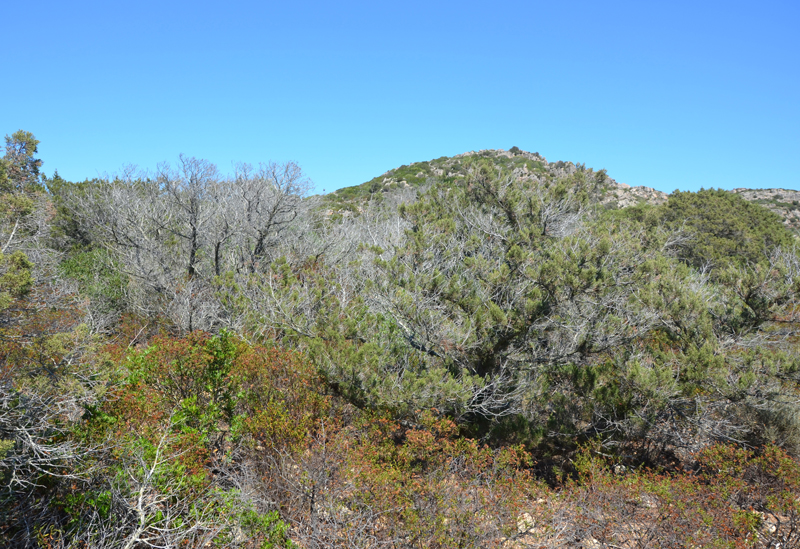 dead and dying trees of Juniperus phoenicea with abnormal production of epicormic shoots caused by Phytophthora crassamura in Sardinia, Italy; photo by Bruno Scanu. Universitagrave; degli Studi di Sassari, Italy
dead and dying trees of Juniperus phoenicea with abnormal production of epicormic shoots caused by Phytophthora crassamura in Sardinia, Italy; photo by Bruno Scanu. Universitagrave; degli Studi di Sassari, Italy
dead and dying trees of Juniperus phoenicea with abnormal production of epicormic shoots caused by Phytophthora crassamura in Sardinia, Italy; photo by Bruno Scanu. Università degli Studi di Sassari, Italy
Phytophthora spp. in subclade 8a: portion of the seven-loci ML phylogeny featuring the type cultures of 212 described species (by T. Bourret). Notice the position of P. cryptogea Ex-type CBS 113.19 = S&T BL 16. Gloria Abad, USDA S&T.
Phytophthora spp. in subclade 8a: Morphological Tabular key (PDF) and Tabular key legends (PDF) in IDphy2 KEY SECTION. Notice the data of P. cryptogea Ex-type CBS 113.19 = S&T BL 16. Gloria Abad, USDA S&T.
 Phytophthora cryptogea (CPHST BL 16) colonies of the ex-type grown for 7 days on (a) V8reg; Agar, (b) potato dextrose agar, and (c) malt extract agar; photo by Krysta Jennings and Leandra Knight, USDA-APHIS-PPQ
Phytophthora cryptogea (CPHST BL 16) colonies of the ex-type grown for 7 days on (a) V8reg; Agar, (b) potato dextrose agar, and (c) malt extract agar; photo by Krysta Jennings and Leandra Knight, USDA-APHIS-PPQ
Phytophthora cryptogea (CPHST BL 16) colonies of the ex-type grown for 7 days on (a) V8® Agar, (b) potato dextrose agar, and (c) malt extract agar; photo by Krysta Jennings and Leandra Knight, USDA-APHIS-PPQ
Phytophthora spp. in subclade 8b: portion of the seven-loci ML phylogeny featuring the type cultures of 212 described species (by T. Bourret). Notice the position of P. dauci Ex-type CBS 127102 = S&T BL 96. Gloria Abad, USDA S&T.
Phytophthora spp. in subclade 8b: Morphological Tabular key (PDF) and Tabular key legends (PDF) in IDphy2 KEY SECTION. Notice the data of P. dauci Ex-type CBS 127102 = S&T BL 96. Gloria Abad, USDA S&T.
Phytophthora spp. in subclade 9c: portion of the seven-loci ML phylogeny featuring the type cultures of 212 described species (by T. Bourret). Notice the position of P. docyniae Ex-type CBS 148031. Gloria Abad, USDA S&T.
Phytophthora spp. in subclade 9c: Morphological Tabular key (PDF) and Tabular key legends (PDF) in IDphy2 KEY SECTION. Notice the data of P. docyniae Ex-type CBS 148031. Gloria Abad, USDA S&T.
chrysanthemum colony morphology after 7 d growth at 20ºC on potato dextrose agar
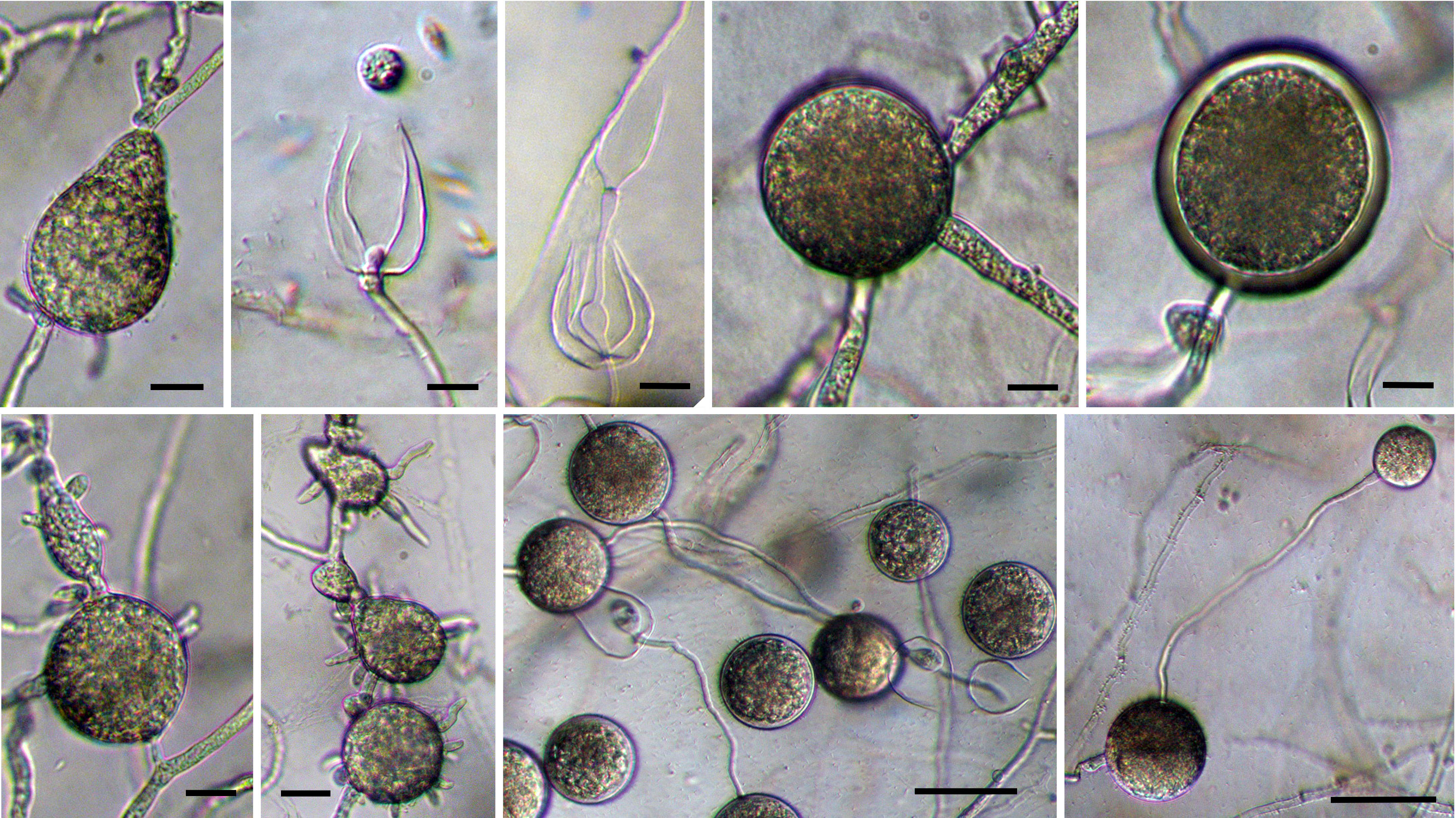 ovoid sporangia with direct germination; internal nested and extended proliferation; intercalary chlamydospore; thick-walled chlamydospore on PDA, chlamydospores germinating to produce sporangia; chlamydospores and hyphal swelling with projections; scale bar = 40micro;m
ovoid sporangia with direct germination; internal nested and extended proliferation; intercalary chlamydospore; thick-walled chlamydospore on PDA, chlamydospores germinating to produce sporangia; chlamydospores and hyphal swelling with projections; scale bar = 40micro;m
ovoid sporangia with direct germination; internal nested and extended proliferation; intercalary chlamydospore; thick-walled chlamydospore on PDA, chlamydospores germinating to produce sporangia; chlamydospores and hyphal swelling with projections; scale bar = 40µm
Phytophthora spp. in subclade 8a: portion of the seven-loci ML phylogeny featuring the type cultures of 212 described species (by T. Bourret). Notice the position of P. drechsleri selected specimen CBS 292.35 = S&T BL 17. Gloria Abad, USDA S&T.
Phytophthora spp. in subclade 8a: Morphological Tabular key (PDF) and Tabular key legends (PDF) in IDphy2 KEY SECTION. Notice the data of P. drechsleri selected specimen CBS 292.35 = S&T BL 17. Gloria Abad, USDA S&T.
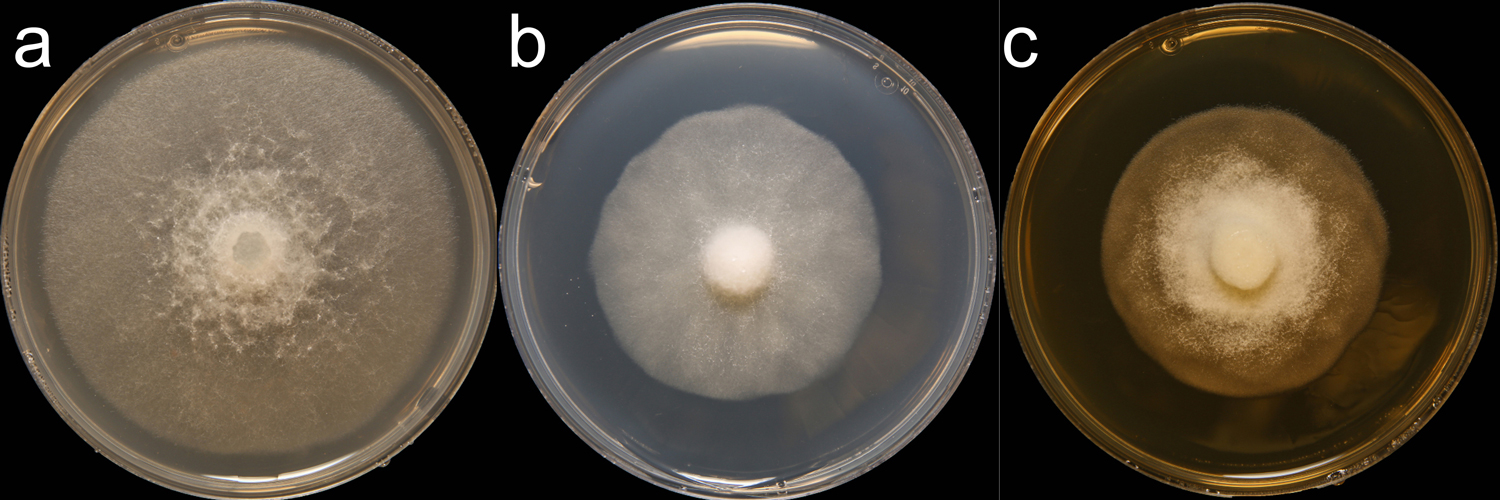 Phytophthora dreschsleri (CPHST BL 140) colonies of selected specimen #2 grown for 7 days on (a) V8reg; Agar, (b) potato dextrose agar, and (c) malt extract agar; photo by Krysta Jennings and Leandra Knight, USDA-APHIS-PPQ
Phytophthora dreschsleri (CPHST BL 140) colonies of selected specimen #2 grown for 7 days on (a) V8reg; Agar, (b) potato dextrose agar, and (c) malt extract agar; photo by Krysta Jennings and Leandra Knight, USDA-APHIS-PPQ
Phytophthora dreschsleri (CPHST BL 140) colonies of selected specimen #2 grown for 7 days on (a) V8® Agar, (b) potato dextrose agar, and (c) malt extract agar; photo by Krysta Jennings and Leandra Knight, USDA-APHIS-PPQ
 Phytophthora drechslerinbsp; (CPHST BL 140, selected specimen) asexual phase: (a) sporangia and hyphal swellings (HS marked in red area); (b-g) different shapes of nonpapillate persistent sporangia; (b) hyphal swellings in sporangiophore (red arrow); (e) sporangium with tapered base; photos by Gloria Abad, USDA-APHIS-PPQ.
Phytophthora drechslerinbsp; (CPHST BL 140, selected specimen) asexual phase: (a) sporangia and hyphal swellings (HS marked in red area); (b-g) different shapes of nonpapillate persistent sporangia; (b) hyphal swellings in sporangiophore (red arrow); (e) sporangium with tapered base; photos by Gloria Abad, USDA-APHIS-PPQ.
Phytophthora drechsleri (CPHST BL 140, selected specimen) asexual phase: (a) sporangia and hyphal swellings (HS marked in red area); (b-g) different shapes of nonpapillate persistent sporangia; (b) hyphal swellings in sporangiophore (red arrow); (e) sporangium with tapered base; photos by Gloria Abad, USDA-APHIS-PPQ.
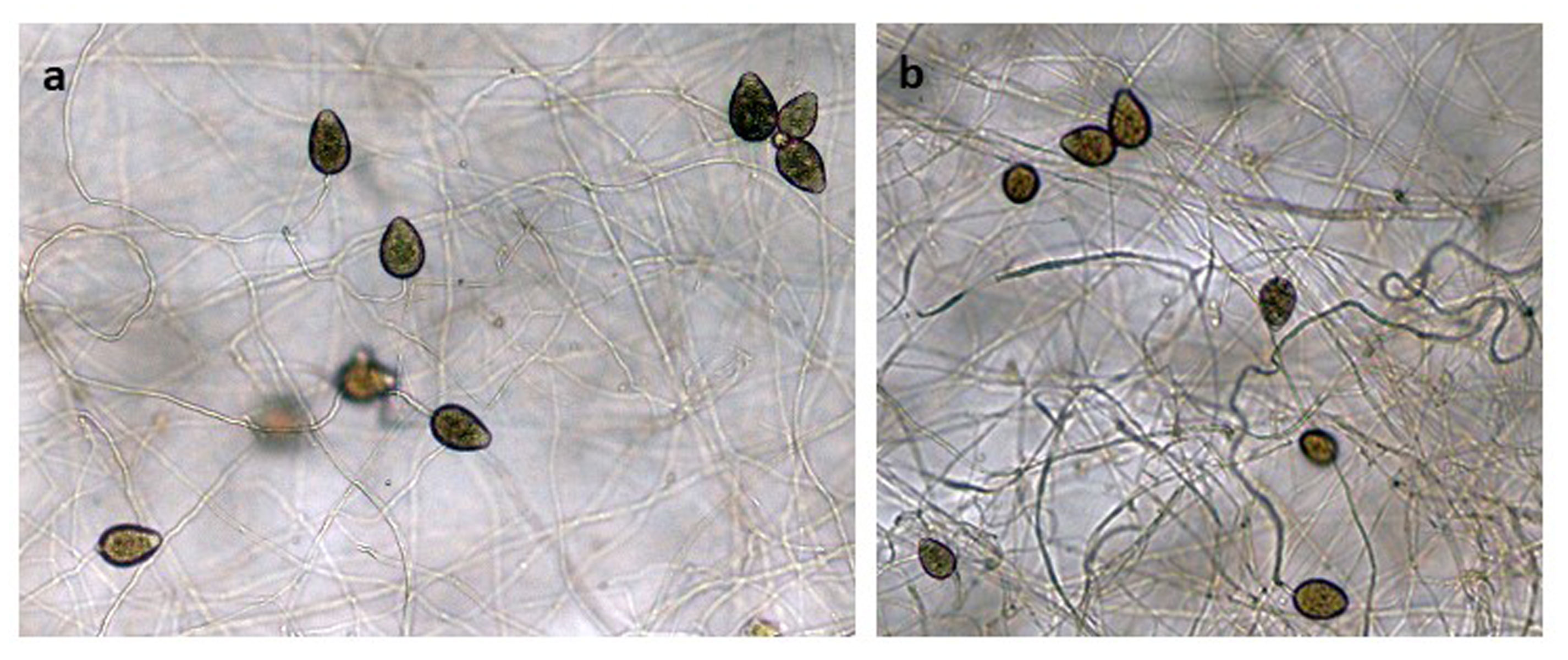 Phytophthora drechsleri (CPHST BL 140) selected specimen asexual phase: nonpapillate persistent sporangia originated in unbranched sporangiophores; photos by Gloria Abad, USDA-APHIS-PPQ
Phytophthora drechsleri (CPHST BL 140) selected specimen asexual phase: nonpapillate persistent sporangia originated in unbranched sporangiophores; photos by Gloria Abad, USDA-APHIS-PPQ
Phytophthora drechsleri (CPHST BL 140) selected specimen asexual phase: nonpapillate persistent sporangia originated in unbranched sporangiophores; photos by Gloria Abad, USDA-APHIS-PPQ
 Phytophthora drechsleri (CPHST BL 17) selected specimen asexual phase (a, b): globose, catenulate (rosary shape), and frequently clustered hyphal swellings; photos by G. Abad, USDA-APHIS-PPQ
Phytophthora drechsleri (CPHST BL 17) selected specimen asexual phase (a, b): globose, catenulate (rosary shape), and frequently clustered hyphal swellings; photos by G. Abad, USDA-APHIS-PPQ
Phytophthora drechsleri (CPHST BL 17) selected specimen asexual phase (a, b): globose, catenulate (rosary shape), and frequently clustered hyphal swellings; photos by G. Abad, USDA-APHIS-PPQ
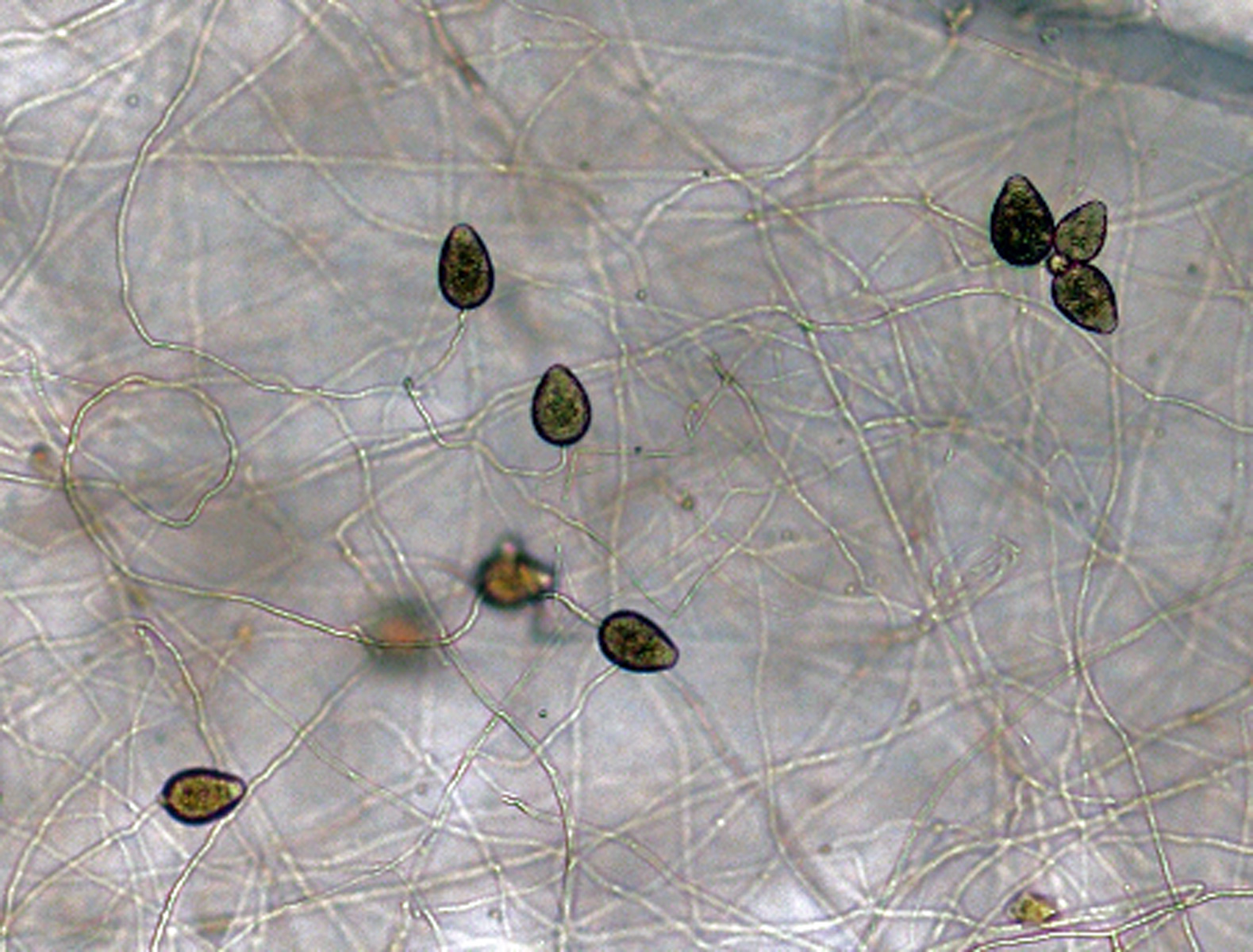 Phytophthora drechslerinbsp; (CPHST BL 140, selected specimen) asexual phase: nonpapillate persistent sporangia originated in unbranched sporangiophores; photonbsp;by Gloria Abad, USDA-APHIS-PPQ.
Phytophthora drechslerinbsp; (CPHST BL 140, selected specimen) asexual phase: nonpapillate persistent sporangia originated in unbranched sporangiophores; photonbsp;by Gloria Abad, USDA-APHIS-PPQ.
Phytophthora drechsleri (CPHST BL 140, selected specimen) asexual phase: nonpapillate persistent sporangia originated in unbranched sporangiophores; photo by Gloria Abad, USDA-APHIS-PPQ.


